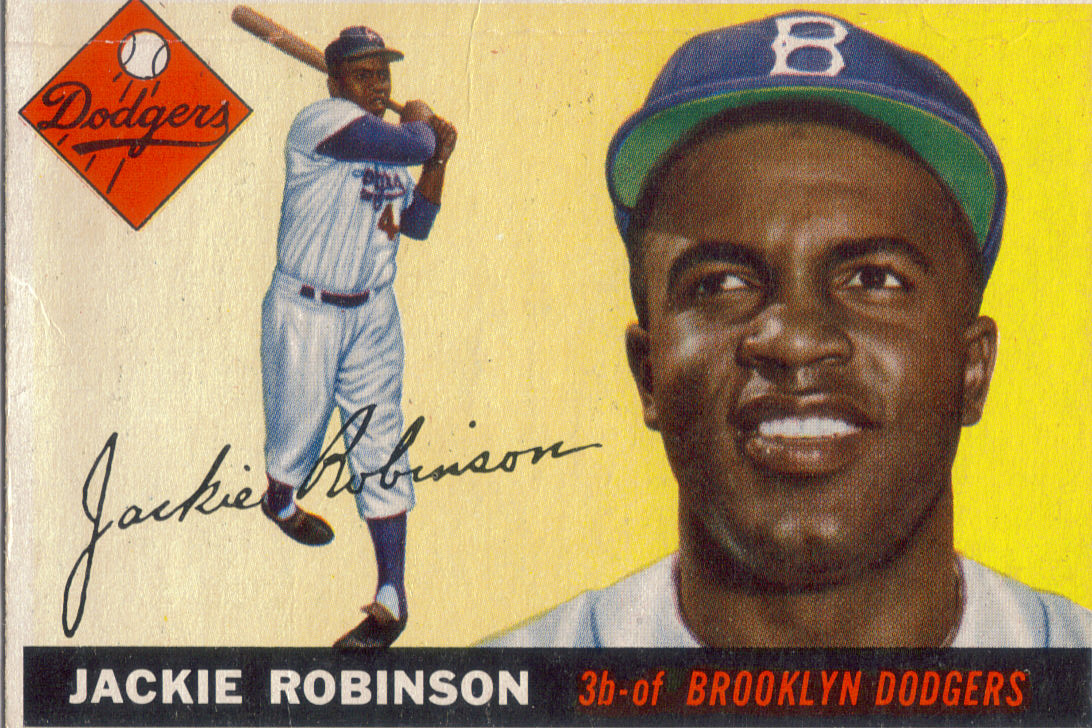~For Ken Schropshire
Spring is here and baseball and integration are in the air!
Everywhere we turn the idea of racial integration—from the recent films Lincoln and The Help to the GOP’s current tactical shift recognizing nonwhites as (gasp) potential voters—is painted primarily as a benevolent act of the majority, as a change of moral heart. While in many instances this may be true, one cannot overlook that social, political and economic progress has, for the most part, had to be taken by the oppressed through righteous indignation and force.
Yet another angle is pursued in the new film 42, which tells the story of Jackie Robinson’s crossing baseball’s color line in the mid-1940s. To the president of the Brooklyn Dodgers, allowing a Negro to play on his team was first and foremost grand sensationalism that would translate into profitable business, leaving the good sport/moral high ground stuff as after thought. The first few minutes of the movie lays out what was at stake at this charged historical moment in “documentary” style: spoken narration quickly lays out the state of race relations with historical footage and period “race music” as the soundtrack.
And that’s where dispassionate “realism” ends. The remainder of the film is a study on how to universalize, and to some degree, soften the jagged edges, of the equality struggle. 42 takes us back to the days when black cultural forms (the Negro press corps, sports, music, literature, etc.) were, indeed, important agents against the forces of Jim Crow in a rapidly changing world. For many, integration represented the fight for a better world for the next generation. For others, it represented a smart business plan. By dipping into the talent pool of the Negro League, Branch Rickey’s (president of the Brooklyn Dodgers) actions mirrored that of white music industry execs who used the black music charts as a barometer for what “race music” songs might be successful in the Top 40 charts. It’s how “crossover” worked for many years.
 Rickey’s plan succeeded. Robinson’s presence galvanized the sports world and beyond. He became a symbol of both hate and hope. The actors that portray Jackie and Rachel Robinson look as attractive on screen as the couple did in real life. Their good looks, middle-class status, pride and social polish made them the perfect poster couple for change—the spoonful of sugar that made the medicine go down.
Rickey’s plan succeeded. Robinson’s presence galvanized the sports world and beyond. He became a symbol of both hate and hope. The actors that portray Jackie and Rachel Robinson look as attractive on screen as the couple did in real life. Their good looks, middle-class status, pride and social polish made them the perfect poster couple for change—the spoonful of sugar that made the medicine go down.
Interestingly, 42’s musical address does similar cultural work in the soundtrack.
This film could have been easily tracked with a compiled score of period music (like the opening) or with more contemporary “protest” songs. There’s, of course, an ample supply of music that would have situated the storyworld in this particular historical moment perfectly. And a more dramatic choice could have been to score with some overtly militant music—from 1970s funk to rap—that captured some of the more uncomfortable aspects of the script. In that scenario Robinson’s inner emotional state would have seemed “dangerous” for some, too specifically and raging black for mass consumption minded audiences.
 Brian Helgelard, the film’s director, chose another aesthetic route. Against casual and extreme instances of racist indignities—from colored restrooms to violence—the score, through its use of extra-diegetic original orchestral music (by Mark Isham) that could have been used in any film from a Western to a soap opera, softened and universalized Robinson’s plight and inner thought life. This use of music from classic Hollywood cinema era the film scholar Anahid Kassabian argues “assimilates” viewers—irrespective of their backgrounds—“into socially and historically unfamiliar positions.” In other words, we are aesthetically seduced to have the same reaction to the storyline. If other music had been used, say rap or funk, viewers would be encouraged to bring their individual listening histories with those genres into their interpretive experience of the film. Thus, 42 safely presents Robinson’s saga as a universal one, a struggle with which all audience members are urged to identify.
Brian Helgelard, the film’s director, chose another aesthetic route. Against casual and extreme instances of racist indignities—from colored restrooms to violence—the score, through its use of extra-diegetic original orchestral music (by Mark Isham) that could have been used in any film from a Western to a soap opera, softened and universalized Robinson’s plight and inner thought life. This use of music from classic Hollywood cinema era the film scholar Anahid Kassabian argues “assimilates” viewers—irrespective of their backgrounds—“into socially and historically unfamiliar positions.” In other words, we are aesthetically seduced to have the same reaction to the storyline. If other music had been used, say rap or funk, viewers would be encouraged to bring their individual listening histories with those genres into their interpretive experience of the film. Thus, 42 safely presents Robinson’s saga as a universal one, a struggle with which all audience members are urged to identify.
It’s a good business plan. As Rickey knew and said in the film, the color of the dollar is ultimately what matters to many in the end. 42 topped the box office its first weekend out.
Tags: 42, baseball, Brooklyn Dodgers, film, Film music, integration, Jackie Robinson, Race Music, Rachel Robinson


 Share On Facebook
Share On Facebook Tweet It
Tweet It




